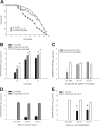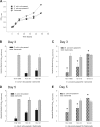Competition and resilience between founder and introduced bacteria in the Caenorhabditis elegans gut
- PMID: 22184417
- PMCID: PMC3294642
- DOI: 10.1128/IAI.05522-11
Competition and resilience between founder and introduced bacteria in the Caenorhabditis elegans gut
Abstract
The microbial communities that reside within the intestinal tract in vertebrates are complex and dynamic. In this report, we establish the utility of Caenorhabditis elegans as a model system for identifying the factors that contribute to bacterial persistence and for host control of gut luminal populations. We found that for N2 worms grown on mixed lawns of bacteria, Salmonella enterica serovar Typhimurium substantially outcompeted Escherichia coli, even when E. coli was initially present at 100-fold-higher concentrations. To address whether innate immunity affects the competition, the daf-2 and daf-16 mutants were studied; their total gut bacterial levels reflect overall capacity for colonization, but Salmonella outcompeted E. coli to an extent similar to wild-type worms. To address the role of virulence properties, Salmonella Δspi-1 Δspi-2 was used to compete with E. coli. The net differential was significantly less than that for wild-type Salmonella; thus, spi-1 spi-2 encodes C. elegans colonization factors. An E. coli strain with repeated in vivo passage had an enhanced ability to compete against an in vitro-passed E. coli strain and against Salmonella. Our data provide evidence of active competition for colonization niches in the C. elegans gut, as determined by bacterial factors and subject to in vivo selection.
Figures









References
-
- Aballay A, Ausubel FM. 2002. Caenorhabditis elegans as a host for the study of host-pathogen interactions. Curr. Opin. Microbiol. 5:97–101 - PubMed
-
- Aballay A, Drenkard E, Hilbun LR, Ausubel FM. 2003. Caenorhabditis elegans innate immune response triggered by Salmonella enterica requires intact LPS and is mediated by a MAPK signaling pathway. Curr. Biol. 13:47–52 - PubMed
-
- Aballay A, Yorgey P, Ausubel FM. 2000. Salmonella typhimurium proliferates and establishes a persistent infection in the intestine of Caenorhabditis elegans. Curr. Biol. 10:1539–1542 - PubMed
-
- Alegado RA, Tan MW. 2008. Resistance to antimicrobial peptides contributes to persistence of Salmonella typhimurium in the C. elegans intestine. Cell. Microbiol. 10:1259–1273 - PubMed
-
- Apfeld J, Kenyon C. 1999. Regulation of lifespan by sensory perception in Caenorhabditis elegans. Nature 402:804–809 - PubMed
Publication types
MeSH terms
Substances
Grants and funding
LinkOut - more resources
Full Text Sources
Miscellaneous

